M. Isidora Forrest's Blog, page 9
June 16, 2024
Isis Magic & Offering to Isis (will be) Back!
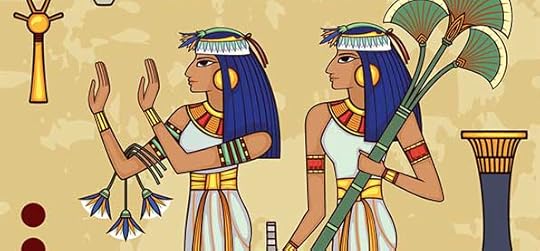
Hello, Isiacs!
I am thrilled to let you know that both Isis Magic and Offering to Isis WILL be back.
Offering to Isis: Knowing the Goddess Through Her Sacred Symbols is being published with updated text and new illustrations of the offerings later this year (2024). It is from Azoth Press and will be available from Miskatonic Books. I’ll share more information as soon as I have it.
Isis Magic: Cultivating a Relationship with the Goddess of 10,000 Names, 25th Anniversary Edition will be available in spring of 2026. It will be published by REDFeather, Mind, Body, Spirit, which is known for its beautiful oracle decks and other topics in personal transformation and empowerment.
Oh, you saw that “25th Anniversary Edition” thing, too? Woof. I can’t believe it’s been that long. On the other hand, when I think of the tiny Mac computer with the floppy disks that I first started writing Isis Magic on while seated at our kitchen table, I actually can believe it.
As those of you who have been following along with this blog know, I don’t talk much about myself here. I prefer to keep the focus on Her. She’s the reason you’re here. She’s the reason I’m here. And She’s the reason both of these books are here. But I thought I’d break my rule just a little bit to share with you something about me and how these books came to be…

The earliest I can remember writing stories was in the sixth grade. Influenced by the spy TV shows that were popular at the time, I wrote about secret agent cats and their clandestine organization, P.U.R.R. Yeah, you don’t want to know what that stood for.
Next, I graduated to monster and horror stories inspired by the Creepy and Eerie graphic novels (we called them comic books then, but they were graphic novels).

I never really thought of myself as a capital-w Writer, though I made my living from marketing writing. During this time, I learned how to research. I found The Goddess and connected with my local Pagan communities. I studied magic and psychism, both on my own and through training in a Hermetic magical tradition. And of course—I’m sure I share this with many of you—I never lost my deep interest in ancient Egypt.
With all that in the background, it isn’t really surprising that, when I did find Isis—or She found me—that the task She wanted me to do was to write books for Her.
As I worked on that little Mac on the kitchen table, I researched to discover everything about Isis that I could find in order to bring it all together in one book. (There was no Google when I began. I know; shocking.) The devotions, meditations, and rituals in both books were inspired by what I learned about ancient Egypt and by Her. In fact, She used many of them to train me as Her priestess. One piece of UPG (unverified personal gnosis) that She gave me during the writing of these books, is that these books would bring seven important devotees to Her service. They would be leaders and would help more people come to know Her.
I hope this has already happened. I hope you’re one of them.
So. Those are the bare bones of the story of Isis Magic and Offering to Isis. I’ll keep you up to date on when the new editions will be available and share with you any new information as it comes along. Thank you all for your devotion to—and if you’re new here, interest in—Isis. She is the most wonderful and magical of Goddesses. She is Divine Magic, Divine Wisdom, Divine Power, and Divine Love. And She IS.
 The House of Isis is open unto you. It always has been. Come.
The House of Isis is open unto you. It always has been. Come.
June 9, 2024
The Goddess Werethekau & Isis
“O, Isis, Great of Magic, deliver me from all bad, evil, and typhonic things…” —Ebers Papyrus, 1500 BCE
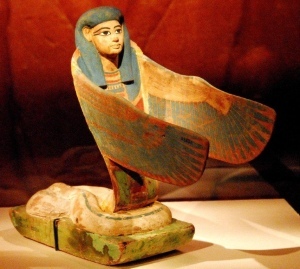 Werethekau as a winged Cobra Goddess (photo by Mark Williams)
Werethekau as a winged Cobra Goddess (photo by Mark Williams)One of Isis’ most powerful epithets is “Great of Magic,” which you may also see translated as Great One of Magic, Great Sorceress, or Great Enchantress. In Egyptian, it is Weret Hekau or Werethekau. (“Wer” is “great” and “et” is the feminine ending. “Hekau” is the plural of “magic,” so you could also translate it as Great of Magics.)
Isis is not the only Goddess Who is called Great of Magic. Indeed, many of the Great Goddesses bear that epithet: Hathor, Sakhmet, Mut, Wadjet, among others. Gods are also Great of Magic, notably Set in the Pyramid Texts.
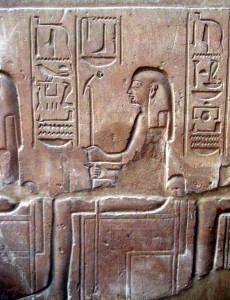 Werethekau from Karnak
Werethekau from KarnakThere is also a Werethekau Who is a Goddess in Her own right, rather than an epithet. As so many Deities were, She was associated with the king, and especially during his coronation. There had been some doubt among Egyptologists about whether Werethekau was indeed a separate Goddess. But recently, Ahmed Mekawy Ouda of Cairo University has been doing a lot of work tracking Her down. He’s gathered references to a priesthood and temples for Her that seem quite clear. More on all that in a moment.
In addition to the Great of Magic Deities, there are objects called Great of Magic, especially objects associated with the king, such as the royal crowns. In the Pyramid Texts, the king goes before a very personified Red Crown:
“The Akhet’s door has been opened, its doorbolts have drawn back. He has come to you, Red Crown; he has come to you, Fiery One; he has come to you, Great One; he has come to you, Great of Magic—clean for you and fearful because of you . . . He has come to you, Great of Magic: he is Horus, encircled by the aegis of his eye, the Great of Magic.”
—Pyramid Texts of Unis, 153
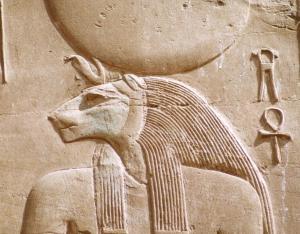 A lioness-headed Werethekau from Karnak
A lioness-headed Werethekau from KarnakSome amulets, including a vulture amulet, a cobra amulet, and, as in the example above, the Eye of Horus amulet are also called Great of Magic. So is the adze used in the Opening of the Mouth ceremony.
With all this great magic going for him or her, the king or queen becomes Great of Magic, too. King Pepi Neferkare is told, “Horus has made your magic great in your identity of Great of Magic” (Pyramid Texts of Pepi, 315). Queen Neith is told, “Horus has made your magic great in your identity of Great of Magic. You are the Great God” (Pyramid Texts of Neith, 225).
I wonder whether there might be some primordial connection between the Great of Magic royal crowns and the Great of Magic royal throne—Who is Iset, the Goddess Throne. There is a votive stele that shows Werethekau and gives Her the epithet Lady of the Throne of the Two Lands. Perhaps we can understand the accouterments of kingship as personified extensions of the Power, Divinity, and Magic of the Living Great Goddesses, which were empowered by Them in order to bestow upon the king his own power, divinity, and magic.
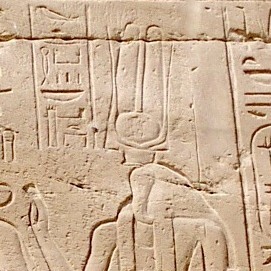 A cobra-headed Werethekau…also from Karnak. Lots of Great of Magics at Karnak, eh? Or should that be Greats of Magic?
A cobra-headed Werethekau…also from Karnak. Lots of Great of Magics at Karnak, eh? Or should that be Greats of Magic?The magic of the crowns is enhanced by the protective uraeus serpents often shown upon them. They’re not just snakes, of course; They’re Goddesses. Most often, the Uraeus Goddesses are Wadjet and Nekhbet or Isis and Nephthys, representing Lower and Upper Egypt. But Werethekau is a Uraeus Goddess, too. The uraei are also known as “Eyes” due to the similarity between the Egyptian word for “eye” (iret) and the word for “the doer” (iret)—because it is the Eyes of the Deities that are the Divine Powers which go out to do things. (Very similar to the active and feminine Shakti power in Hinduism.)
The Pyramid Texts of King Merenre associate the Eyes with the crowns:
“You are the god who controls all the Gods, for the Eye has emerged in your head as the Nile Valley Great-of-Magic Crown, the Eye has emerged in your head as the Delta Great-of-Magic Crown, Horus has followed you and desired you, and you are apparent as the Dual King, in control of all the Gods and Their kas as well.”
—Pyramid Texts of Merenre, 52
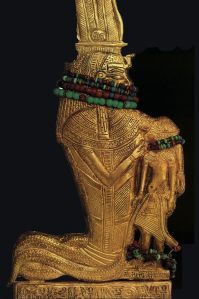 The human-headed Cobra Goddess Werethekau nursing Tutankhamum
The human-headed Cobra Goddess Werethekau nursing TutankhamumThe Uraeus Goddesses or Eyes are powerful, holy cobras Who emit Light and spit Fire against the enemies of the king and the Deities. Learn more about Isis as Uraeus Goddess here.
When Werethekau is an independent Goddess, She may have the body of a woman and head of a cobra, be in full cobra form, and we even have a few instances of the Goddess in full human form. Among Tutankhamun’s grave goods is a figure of Werethekau with a human head and cobra body nursing a child Tut.
She also has a lioness form. We know of a lionine Isis-Werethekau from the hypostyle hall at Karnak. A number of the Goddesses with a feline form—Sakhmet, Mut, Pakhet—were also known as Great of Magic, so we can understand that powerful magic has not only a protective and nurturing side, but also a fierce and raging one. Which seems about right if you ask me; magic can be very positive and healing or, if used unwisely, a real mess.
 Isis-Werethekau from the Great Hypostyle Hall at Karnak. You can read Her name in the hieroglyphs above Her. Click to enlarge.
Isis-Werethekau from the Great Hypostyle Hall at Karnak. You can read Her name in the hieroglyphs above Her. Click to enlarge.So far, I haven’t tracked down the oldest reference to Isis as Great of Magic. Since She has always been a Goddess of great magical power, the association is ancient. Perhaps it has always been. Perhaps there’s something to my guess about The Great-of-Magic Throne. Or perhaps Professor Ouda will come to my rescue if I can ever get a copy of his thesis about this.
In Ouda’s article outlining some of the references to Werethekau’s priesthood and temples, several of the extant references to Werethekau also tie-in Isis and Her Divine family.
For instance, on a stele of a chantress of Isis, the chantress is shown playing the sistrum and adoring Isis-Werethekau. The inscription reads, “adoring Werethekau, may They [Isis and Werethekau?] give life and health to the ka of the chantress of Isis, Ta-mut-neferet (Isis the Beautiful Mother).” In fact, on the less-than-a-dozen votive stele we have and on which Werethekau is named or depicted, many of them are stele for people who served Isis in some priestly capacity; they may have also served Osiris and Horus, too.
Ta-mut-neferet holds the hand of a man identified as “the servant of Osiris.” Another stele calls Werethekau “Lady of the Palace” and is dedicated by a chantress of Osiris, Horus, and Isis. A man who was Second God’s Servant of Osiris, God’s Servant of Horus, and God’s Servant of Isis was also God’s Servant of Werethekau, Lady of the Palace.
 Iset Werethekau in hieroglyphs…three different ways
Iset Werethekau in hieroglyphs…three different waysOuda also notes that Lady of the Palace may be Werethekau’s most common epithet. That is quite interesting in light of the fact that Lady of the Palace (or House or Temple) is the very meaning of Nephthys’ name. (Learn more about that here.) And of course, She, too, is called Great of Magic. Together, Isis and Nephthys are the Two Uraeus Goddesses and the Two Greats of Magic.
So if the question is, “is Werethekau an independent Goddess, a personified object, or an epithet of other Deities?”, the answer is, “yes”. With the beautiful and, to my mind, admirable fluidity of the Egyptian Divine, She is all these things…and most especially, a powerful aspect of Isis, the Great Enchantress.
May 26, 2024
Isis & Hekate Part 2
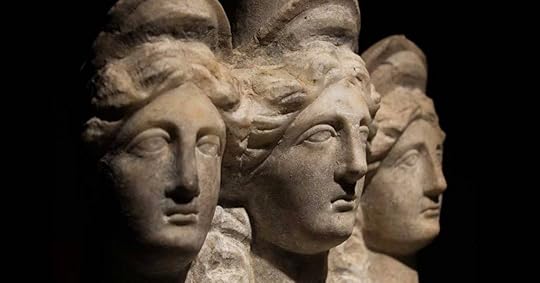 Triple Hekate, Goddess of Magic
Triple Hekate, Goddess of MagicLast time, we wondered how it was that the ancient Egyptians and Greeks could see a harmony, or even an equivalence, between Isis and Hekate. So, as promised, let’s look at some of the correspondences between these two Goddesses so we can understand a bit better what they were thinking.
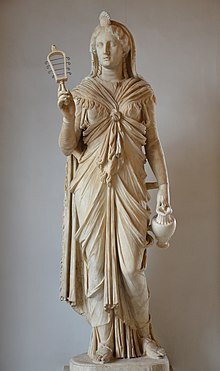 A Roman image of Isis from Hadrian’s villa
A Roman image of Isis from Hadrian’s villaGoddesses of Magic
Let’s start with the most obvious one: magic. Isis is arguably the most powerful Egyptian Goddess of Magic, or heka in Egyptian (later, hik in Coptic). In Egypt, heka is the power that underlies and empowers all of Creation. So naturally, all the Egyptian Deities have the power of heka. Yet, as time went on, it was Isis and Thoth Who stood out as Goddess and God of Magic, both for the strength of Their magical powers and the depth of Their magical knowledge.
Hekate is the Hellenic Goddess of magic and witchcraft. Sometimes, Hekate’s magic has a bit of a darker flavor than that of Isis for She is often associated with pharmaka, magical arts and spells, but which can also be drugs, both beneficial and poisonous.
Both Goddesses are also known to teach the magical arts to Their devotees.
While traveling the wilds of the internet, you may have seen some people saying that Hekate’s name may be derived from a.) the Egyptian Frog Goddess of Fertility Heqet or Heket, or b.) from the Egyptian word for magic, heka. For the connection with Heqet, we have this speculation from Martin Bernal (author of the Black Athena series):
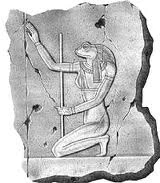 Heqet
Heqet“The crone goddess Hekate [note: Hekate was never a crone] was central to the Eleusinian Mysteries, whose name, like that of nearly all Greek divinities, has no Indo-European etymology. Her name almost certainly derives from the Egyptian frog goddess Hkt or Hqt. Both were versed in magic—ḥk3 in Egyptian—and fertility. There is, to my knowledge, only one connection drawn between Hekate and frogs. This comes in Aristophanes’ parody of the Eleusinian initiation, “The Frogs,” where the chorus condemns those who defile Hekate’s shrine. The chorus of frogs appears while the travellers are crossing to Hades on Kharon’s ferry. In the Egyptian Coffin Texts of the Middle Kingdom, Sokar’s ferry to the Underworld is reported to have “her bailers . . . [as] the frog goddess Hqt at the mouth of her lake.” (Martin Bernal, “Egyptians in the Hellenistic Woodpile” in Ptolemy Philadelphus II and His World)
 Isis works Her magic on Re
Isis works Her magic on ReWhile Bernal has been heavily criticized for making these kinds of leaps (e.g. “almost certainly”), I do find his work very valuable in helping trace connections between the you-simply-couldn’t-ignore-it ancient Egyptian civilization and that of the ancient Greeks. Nevertheless, this one looks like quite the stretch to me. The frog connection is pretty tenuous and Heqet was never well known enough outside of Egypt to be that influential. A better correspondence might be between Isis’ title of Hekaiet, “Magician,” and Hekate, but I can’t offer further speculation on that as I’m no linguist.
Universal Goddesses
Both Goddesses are powerful in every sphere of life, on every level of reality. Isis is said to be queen of earth, heaven, and underworld. Hesiod, in the Theogony tells us that Hekate has power in earth, sea, and sky. And while Hesiod doesn’t specifically list the underworld as one of Hekate’s realms, it is clear that Her connections with the dead make Her and underworld Goddess, too. Both Isis and Hekate serve as psychopomps. Hekate guides Persephone back to the land of the living and Isis initiates the newly dead into their new lives.
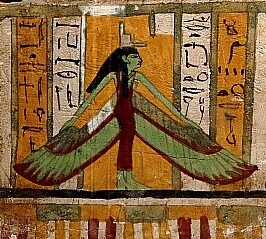 Green Isis spreads Her wings over the deceased
Green Isis spreads Her wings over the deceasedProtective Goddesses
With Her widespread wings, Isis is the protective Goddess par excellence. She not only protects Her child Horus, Her husband Osiris, and the land of Egypt, but each of Her devotees as well. With Her magical power, Hekate is also a protective Goddess, Her image placed before each household to keep its inhabitants safe.
Child Nurturing Goddesses
Both Isis and Hekate bear the Greek epithet Kourotrophos, “Child Nurturing.” Of course we see Isis nurturing Her own child, Horus, but human children were often placed under Her protection as were young people in general. People often made offering to Hekate asking Her to protect their young as well.
Goddesses of Many Names
 Hekate with guiding torches
Hekate with guiding torchesWith Isis’ astonishing number of syncretizations with Goddesses (and some Gods) both inside and outside of Egypt, as well as Her power in every area of life, She truly earned the title of Myriad-Named. Yet Hekate is also many named and connected with many other Goddesses. I’m going to give Isis the edge in this category, however, because the extent to which this happened with Her was and is simply unprecedented.
Fiery Goddesses
Hekate is strongly associated with burning torches while Isis is a fire-spitting Uraeus Goddess and burning Eye of the Sun.
Goddesses of the Moon
 Isis with lunar crescent
Isis with lunar crescentIn this category, I’ll give Hekate the edge. With Her prominent triplicity, Hekate has an easy connection with the triple visible phases of the moon, as well as Her association with the mysteries of the dark moon and the offerings of Hekate’s suppers. But Isis is not without Her lunar connections. In fact, many modern people first think of Isis as a Moon Goddess. In later periods of Her worship, She was indeed associated with the moon, particularly when Egypt came under Greek rule. For the whole story on Isis as a Moon Goddess, go here.
Savior Goddesses
Both Isis and Hekate are specifically called Savior (Soteira in Greek). Isis was called Soteira as She became universalized in the Hellenistic and Roman periods. Hekate became Soteira through Her role in the Chaldean Oracles as the World Soul. While many of us are used to thinking of “salvation” in Christian terms—believe, and the Deity will forgive your sins, saving your soul for eternal life. But the ancients had a broader definition. Savior Deities could save you from earthly troubles as well as caring for your soul in the afterlife. The Savior Deities also saved people from their fear of death. By being initiated into knowledge of the afterlife and being assured of the favor of their Goddess, people could face their end of life in peace.
Scary Goddesses
 A very scary, demon-like Hecate from the TV show “Charmed”
A very scary, demon-like Hecate from the TV show “Charmed”With Her connection to the dead, especially the restless and unhappy dead who can accompany Her, Hekate can be a frightening Goddess. She might be called upon in necromantic rites—raising the dead for information—which is naturally unsettling. Frightening aspects of the Goddess are called upon in some of the magical spells we have left to us. The Goddess Herself might appear in a frightening form with rattling chains and animalistic moans and roars. But Isis is never scary, is She? Welp. Yes, She can be. Isis’ own connections with Mysteries, death, and the underworld could make Her a Dread Goddess, too. After all, if She can create, She can destroy. The Pyramid Texts include a passage that says, “If Isis comes to you in Her evil coming, do not open your arms to Her.” Other tales tell of Isis killing a prince with an angry glance and that a rash man who tried to sneak into Her sanctuary without an invitation expired on the spot.
Animals of the Goddesses
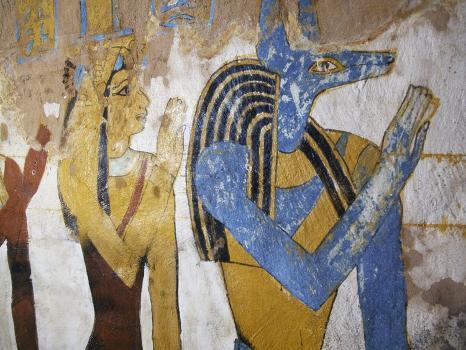 A tomb painting of Isis and Anubis
A tomb painting of Isis and AnubisThe Goddesses also share some connections though the animals that are sacred to both. For instance, both are associated with dogs. Hekate has Her accompanying hounds, whose howls proceed Her arrival. Isis is closely connected with canine Anubis, sometimes even as His foster mother. She is also associated with “the dog star,” Sirius. In one of Her aretalogies, Isis says of Herself, “I am She who rises in the Dog Star.” Both Goddesses are connected with snakes. Hekatean imagery often includes serpents, while Isis Herself is a Cobra Goddess.
 Animal-headed Hekate
Animal-headed HekateHekate is connected with bulls and cows, which were/are considered lunar animals due to the crescent-like horns they bear. Hekate Herself sometimes has the head of a bull as one of Her three animal-form heads. In later periods, Isis shares the crescent-horns-moon association, but She is also a Cow Goddess in Her own right, from very early on. She also is assimilated with Hathor, the most prominent Egyptian Cow Goddess. Like many Asia Minor Goddesses, Hekate is often associated with lions. Sometimes, one of Her animal-form heads is that of a lioness. Isis IS a Lioness Goddess. As the Eye of the Sun, She also takes the form of a fierce lioness and we have a number of portrayals of Isis with the head of a lion, looking quite a bit like Sakhmet. And yes, you guessed it, She is often syncretized with Lioness Sakhmet.
 Pilgrim feet at Philae
Pilgrim feet at PhilaeTemple Footprints for the Goddesses
There is one last correspondence I want to mention, but not dwell on. That’s because it’s interesting enough to deserve it’s own blog post. One of the things pilgrims traveling to temples might do is leave a certain type of graffito scratched into the stones of the temple. The graffito was a foot or pair of feet, often along with a written dedication. They were meant to symbolize the person permanently standing at the temple. We find these pilgrim feet at a number of Isis temples and shrines as well as at Hekate’s temple at Lagina in modern Turkey. Click for info on the sacred graffiti at Isis’ temple at Philae.
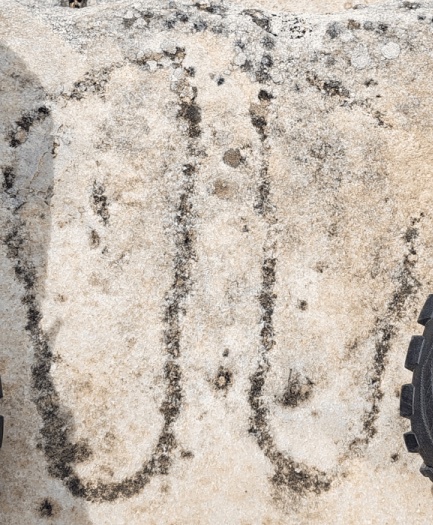 Pilgrim feet from Hekate’s Lagina temple
Pilgrim feet from Hekate’s Lagina templeNo doubt there are other connections that can be made between these two Great Goddesses. But I think this is sufficient for us to understand why the ancient Egyptians and Greeks might have been inclined to associate Them.
So, are Isis and Hekate “the same?” No, not exactly. But are They connected? Yes, They are indeed.
May 19, 2024
Isis & Hekate
 I love this Hekate by Talia Took. Buy her artwork here. She is an amazing artist. I am the delighted owner of several pieces by her.
I love this Hekate by Talia Took. Buy her artwork here. She is an amazing artist. I am the delighted owner of several pieces by her.Enough people have asked me about the connection between Isis and Hekate that I guess it’s time to do some pondering about that. So let’s.
I’ve had the privilege of meeting both these Goddesses in ritual over the years. As you know, I have been a devotee of Isis for, well by now I can round up to “forever.” Hekate has always been in my Dark Goddess mix, but I had an opportunity to serve as Hekate’s oracle at our last community fall equinox celebration—which meant that I spent a lot of time invoking and experiencing Her over an extended period of time in preparation for the rite.
The question before us is often asked as to whether Isis “is the same as” Hekate—as She is so decidedly said to be in several ancient texts that we have left to us. (Specifically, Apuleius’ Golden Ass and the aretalogy of Isis in Oxyrhynchus papyrus 1380, to name two.)
 I have this beautiful Isis from Thalia. I also have a Hekate, interestingly enough.
I have this beautiful Isis from Thalia. I also have a Hekate, interestingly enough.As is so often the case, for me, the answer is both yes and no.
Let’s look at the “no” side of the answer first.
From my personal experience, I can say that the two Goddesses feel quite different. That said, for the festival rite above, I was working very hard to psychically tune into Hekate specifically. I needed to separate myself from my easy connection with Isis and come to a place where I could “hear,” then speak aloud, the words of Hekate. For our ritual, we were invoking both the “witchy” Hekate that so many people are familiar with today, as well as the Theurgic Hekate of the Chaldean Oracles and from Whom at least some of the Oracles were channeled.
How you might answer this question for yourself depends in part on your own experiences and what variety of Pagan (I am using “Pagan” in its broadest, modern sense) you consider yourself to be. If you’re a ‘hard’ polytheist, then your answer is likely to be that They are two quite separate Goddesses and never the twain shall meet. They come from different lands, are part of different pantheons, and are separate personalities with Their own individual needs, wants, and agendas. (All of this is true, of course.)
In this case, the answer to our question is a simple no; Hekate is not the same as Isis nor vice versa. The two Goddesses are quite distinct.
The “yes” side of the answer is, well, a bit more complicated.
And it again depends on what you think about the structure of the Divine Reality and how it works. Here are two posts on some of the various ways we could think about that Divine Reality and how Isis might look through those various lenses: Isis, the One & the Many; and Isis, the One & the Many More.
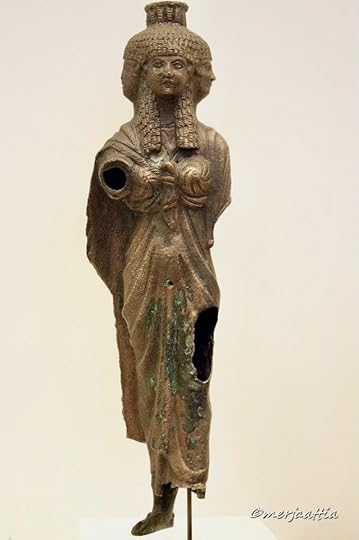 Isis the Magician, with 3 faces. Photo by Merja Attia; see her Flickr here.
Isis the Magician, with 3 faces. Photo by Merja Attia; see her Flickr here.Your answer might also depend on what you think about syncretism or theocrasia, the mixing of Deities, in this case, Isis-Hekate. This is not a modern invention; the ancients did it all the time. It was common throughout the Hellenic and Roman worlds. But it was especially true in Egypt. Egyptian Deities can become one another, take up each other’s traits, or be the ba, or manifestation, of each other. Isis-Hathor is a very Egyptian example.
Isis and Hathor also feel different to me on Their own, and yet They are intimately connected, each residing in the other’s temples and having harmonious attributes and powers. When syncretism was done cross-culturally, I’ve always believed it was a way for people to understand each other’s Deities. “Oh, you’ll like Isis, She’s sorta like Demeter, but different and Egyptian.”
The image you see to the right is identified by the National Archeological Museum of Athens as “Isis the Magician.” She is portrayed like most Hellenistic Isis images: Isis knot between the breasts, Egyptian wig, uraeus crown-base on Her head (the rest of the headdress may be missing). The missing arm probably held a sistrum or a serpent. But She has three faces. This is a very unusual portrayal of Isis. Some Egyptian Deities are shown with multiple heads, but it is usually two or four (the Two Lands frequently prefer even numbers), though triplicities were important in Egyptian symbolism, too.
 Hekate plaque, now in Prague’s Kinsky Palace museum
Hekate plaque, now in Prague’s Kinsky Palace museumHowever, triple faces/heads/bodies are not at all unusual for Hekate. So, are we looking at a syncretic Isis-Hekate in the statuette now in Athens? Is that why the museum has identified the image as “Isis the Magician”? I think so. In Sorita d’Este’s book, Circle for Hekate, she notes another Isis-Hekate on Roman-period coins from Memphis, Egypt. It shows a triple-faced Goddess standing next to the Apis bull, which was considered the ba of Osiris in Memphis. The Apis’ connection with Osiris would argue for the triple-faced Goddess’ identity as Isis, Isis the Magician, or even Isis-Hekate.
Now, I’d like to return to the texts mentioned above, the ones that equate Isis and Hekate—just so you know what they say. The first one is from Apuleius’ ostensibly fictional tale of initiation into the Mysteries of Isis. It is from the speech that the Goddess Herself makes when She comes to rescue the protagonist, Lucius, from having been magically turned into an ass. She lists all the many different names that She is called by people throughout the Mediterranean. She says that She is called Venus and Diana and Ceres and Proserpine (Apuleius is writing in Latin, so the Goddesses are the Roman ones) and Juno and Bellona and Hekate and Rhamnusia (aka Nemesis), but that Her true name is Queen Isis.
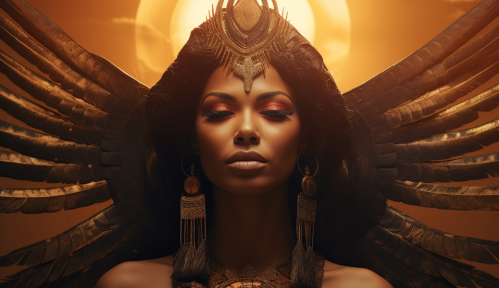 An interesting AI Isis, though the algoes never get the jewelry or crowns right; Her headdress reminds me of my beloved Egyptian Rocket Goddess by Audrey Flack.
An interesting AI Isis, though the algoes never get the jewelry or crowns right; Her headdress reminds me of my beloved Egyptian Rocket Goddess by Audrey Flack.The second one is found in one of the papyri from Oxyrhynchus, Egypt. The text gives the names by which Isis is known in cities throughout Egypt and the Mediterranean. It tells us that in Caria (in Asia Minor), Isis is called Hekate. Some of you may know of Hekate’s great temple at Lagina, Caria. Surely, the author is thinking of this Hekate and naming Her as Isis. Hekate also had a shrine at the temple of Artemis of Ephesus, also in Caria. Who else did? Yep, it was Isis. .
Why was it so easy for these authors, writing in about the second century CE, to identify Isis with Hekate? Well, once you start looking into it, turns out that there are quite a few rather solid connections between the two Goddesses. But since this post has already gotten fairly long already, we’ll detail those next time in Part 2.
May 12, 2024
Isis & the Magic of Myrrh
A hymn to Isis at Her temple in Philae says,
O Isis, giver of life, who dwells in the Pure Island, take to yourself the myrrh which comes from Punt, the lotus-fragrance which issues from your body, that your heart may be glad through it, and that your heart may rejoice every day.
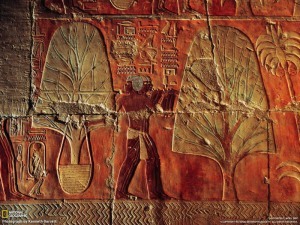 Myrrh trees being planted in an Egyptian garden
Myrrh trees being planted in an Egyptian gardenMyrrh (commiphora myrrha) was one of the most sacred herbal substances of ancient Egypt and was a precious offering given to all the Deities. It was used in two primary forms: essential oil and gum resin. Myrrh oil was considered one of the Seven Sacred Oils of Egypt and the gum resin was frequently burned as incense. Both oil and resin were used in a wide variety of perfumes and medicines.
If you are not familiar with it, myrrh produces a strange and interesting scent. I wouldn’t exactly call it a “lotus fragrance” as the Isis hymn says. In fact, “bitter” is a word you could use of it, but it’s bitter in a good way, like bitter herbs that serve as a catalyst to bring out the flavors of certain foods. When the resin first hits the coal, there is a brief sweet note, but it quickly gives way to a darker burnt-wood scent. I use it as an underworld fragrance, but often mix it with amber to sweeten the scent.
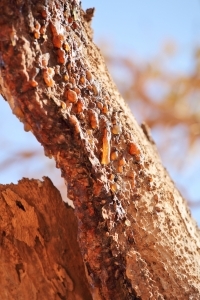 Myrrh resin or “tears” weeping from the tree trunk
Myrrh resin or “tears” weeping from the tree trunkMyrrh resin is exuded by several species of trees native to Arabia and eastern Africa. The Egyptians imported myrrh from Punt, in modern Somalia; and much of the world’s myrrh still comes from that area. In appearance, myrrh trees are small and shrub-like with gnarled branches, triple leaves, and small white flowers. The resin weeps naturally from the trunk and may be easily collected. However, small cuts are often made in the trunk to increase the flow. Thus the resin can be said to result from the wounding and weeping of the tree.
In addition to myrrh’s bitterness, this is perhaps another reason for its association with sorrow, mourning, and death. Myrrh oil was one of the most important used in mummification—so much so that some of Egypt’s ancient mummies still smell of myrrh. “Death is before me today, like the fragrance of myrrh,” says an ancient text known as “The Debate of a Man with His Ba” in which the man is considering suicide. Thus myrrh was sometimes said to have originated in the underworld.
Myrrh is sacred to Isis in Her role as Goddess of Death and Mourning. Myrrh’s bitterness may easily be associated with Isis’ bitter task of searching for the scattered pieces of Her beloved husband’s body. In the magical papyri, myrrh is called the Guide of Isis for it was thought to assist Her in this sorrowful task. While the papyri don’t say specifically how Isis employed Her “guide,” we can speculate that She may have burned it as incense—perhaps as part of a visionary rite—or made it into ink with which to inscribe amulets to aid Her search. A recipe for one such magical ink included myrrh, along with dried figs, date pits, and wormwood. The ritual instructions tell us that this ink was the one Isis used to record Her magical words as She fit together the members of Osiris. Myrrh was also sometimes called the Tears of Horus, perhaps in connection with His own mourning for His father.
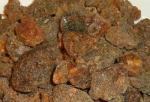 Myrrh tears
Myrrh tearsEven though the Egyptians closely associated myrrh with death, they also connected it with pleasure and power. Myrrh was one of the many fragrances favored by the Lady of Joy, Hathor, and it was an ingredient in many, many of the most famous Egyptian perfumes. In perfume, the slight bitterness of myrrh adds depth to many lighter, sweeter fragrances. In the funerary texts, the deceased was expected to spend pleasant hours living and eating beneath myrrh trees in the otherworld. In one interesting formula, the deceased claims that his putrefaction—the fluid from his decaying body—is actually myrrh and that his Divine Mother Hathor anoints Herself with it. Myrrh was also the incense burned in temples of Re at noon, the time of His greatest power. The strong scent of myrrh reflected the noontime power of the Sun.
 “Offering to Isis” by Sir Edward John Poynter, 1866; perhaps she has myrrh in that little container?
“Offering to Isis” by Sir Edward John Poynter, 1866; perhaps she has myrrh in that little container?Magically, myrrh is used to purify, bless, and protect. It is said to increase the power of any incense with which it is burned. The dark scent of myrrh aids meditation and may be used to awaken our awareness of the spiritual realities behind the everyday world. Thus it is an excellent scent for use not only in meditation, but also before and during magical rites. Because of its association with death, myrrh is often connected with the planets Saturn and Mars, considered planets of ill fortune in ancient astrology. Today’s astrologers take a more balanced view of these two planets—attributing to them stability, strength, and energy. This view is clearly in step with myrrh’s ancient associations with power and protection.
On the practical side, myrrh is slightly antiseptic so the powdered resin may be dusted on sores as a local disinfectant. It is an astringent, a digestive aid, and an anti-gas tonic. Used as a mouthwash, it relieves sore teeth and gums. Taken internally, it cures bad breath and tightens loose teeth. It may be taken for coughs, asthma, and other chest problems. The ancient Egyptians used myrrh for all these purposes and more. From personal experience, I can also add that the essential oil works like a freaky catnip for my cat.
Myrrh is a balm of healing, protection, and care for the dead. It is a scent of spiritual power and energy. As Goddess of Death and Mourning, Lady of Healing, and one of Egypt’s most powerful Goddesses, Isis is the Lady of Myrrh.
May 5, 2024
Who is Aperet-Iset?

The last few weeks have led me to several new connections with Isis that I hadn’t known about previously. I’m sharing the second one with you today. Admittedly, the associations do get a bit obscure, but that’s okay with me. I love teasing out those threads of connection to and for Her.
Today we meet a Goddess named Aperetiset, Aperet-Iset, or Aperet-Isis. She is, apparently, a local Goddess from Akhmim, aka Khemmis, aka Panopolis, in Upper Egypt. There, Her consort is the God of the Upright Phallus, Min, and Their child is Horus the Child. She is also in evidence in Osiris’ cult center of Abydos and at Athribis in Upper Egypt near the edge of the western desert. Great Isis was worshiped with Min at Koptos, not too far from both Upper Egyptian locations. Aperet-Isis is known as far back as the New Kingdom, and then we find Her more frequently throughout the Ptolemaic and later periods.
We have maybe a couple dozen references to Her, and the ones we do have seem rather colorless. She is called the Lady of Akhmim, Mother of the God, Lady of the Two Lands, and The Great—fairly common epithets. But there are two other, more interesting, epithets that I’ll get to in a moment.
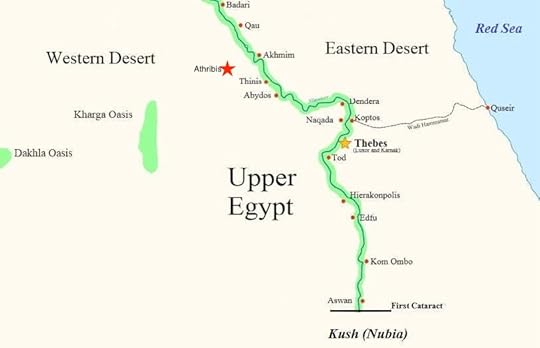 This map shows all the locations we’re discussing
This map shows all the locations we’re discussingFirst, let’s see if we can color outside the lines a bit and bring some additional tinting to our Lady Aperet-Isis.
 Aperet Iset
Aperet IsetFirst of all, Her name. The word “aper” means “to equip.” Aper-et is just “aper” with the feminine ending appropriate for a Goddess or a woman. And so, in the article I’m reading, it is translated as “She Who Equips the Throne,” (remembering that Iset means Throne). With what does She equip the throne? We don’t know. The article doesn’t speculate on that.
Perhaps with sovereignty? Sovereignty is always part of the discussion when it comes to the name of Isis Herself. If Isis IS the Goddess Throne, then to rightly rule, the king must sit in Her lap, on the throne, as Her child. That’s okay, as far as it goes. But Isis is far too expansive a Goddess to be confined to such a limited role. And, as all of you who have been reading along with this blog well know, She never was so confined. In fact, She eventually became The Goddess, the Encompassing All-Goddess, for so many, many of Her worshipers.
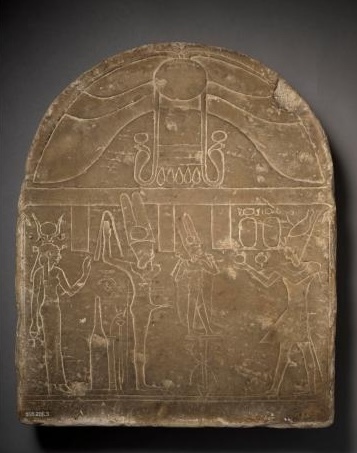 The king offering to Horus the Child, Min, and Aperet-Iset
The king offering to Horus the Child, Min, and Aperet-IsetI happen to be studying something right now that I believe can shed some light on Aperet-Isis.
You might be familiar with some of the forms of the human being, especially prominent after death, such as the ka and the ba. There’s another one called the akh. The dead “become akh” when they have successfully passed through the weighing of the heart during the Judgment of Osiris. You might see them described as “transfigured spirits.” When you’re akh, you have, in essence, become divine. You have all your powers and may travel between the worlds—heaven, earth, or underworld—at will, dwelling with the Goddesses and Gods. Naturally, the Deities are Akh, too, and have even more akh-power than humans who are akh.
There are two adjectives that are almost always used to describe akhs: iqer and aper. In the briefest of definitions, iqer is “effective” and aper is “equipped.”
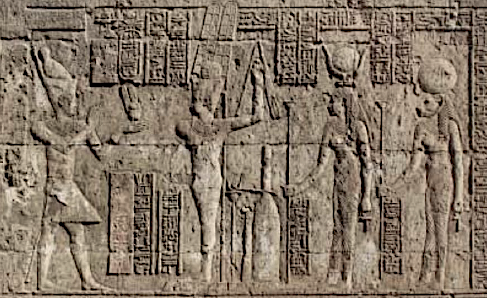 The king offering to Min, Aperet-Iset, and Repyt
The king offering to Min, Aperet-Iset, and RepytAnd with what are the divine akhs equipped? This we do know specifically. They are equipped with magical knowledge and power. Because they are aper—equipped—they are also iqer—effective—in doing whatever it is they wish to accomplish.
So, I think Aperet-Iset is not “She Who Equips the Throne,” but is instead the “Equipped Throne” or—taking Iset as a name rather than an object—”Equipped Isis.” To confirm that, some scholars have indeed understood Aperet-Isis as a form of Great Isis. As we know, being equipped with powerful magic is entirely within the natural purview of the Great Magician Goddess Isis. As Great of Magic, Our Goddess is incredibly competent and fully equipped with all Her magic. In tombs, we sometimes see human akhs describe themselves as “a lector priest who knows his spells.” And we know that Isis the Magician is perfect in casting Her spells, never hesitating or stumbling over a word. So I think we can take Aperet-Isis as a form of Isis that focuses particularly on Her magical strengths.
 Isis the Mother of the God
Isis the Mother of the GodEquipped Isis may use Her magic in service to “the throne,” that is, the kingship. Under Her epithet of Lady of the Two Lands, this makes sense. And Great Isis was always concerned with maintaining the legitimate rule of Her son Horus over Egypt.
While usually shown in woman-form with horns-and-disk crown, vulture headdress, and sometimes two plumes, Aperet-Isis is also occasionally shown as a lioness-headed Goddess. She is usually in the company of other Deities, such as Min, Osiris, Horus, Isis, and Nephthys. In the mammisi, or birthhouse, at Edfu, She is shown with 13 other Goddesses, including two Isises and three Hathors. In Egyptian theology, it is no contradiction to have duplicates of the same Deities shown together, nor is it a contradiction to have a minor form of Isis, Aperet-Isis, shown with other forms of Isis.
 Isis magically reviving Osiris
Isis magically reviving OsirisWe also find Aperet-Isis at Abydos, where Her powerful magic would be needed to resurrect and maintain Osiris. In the area around Akhmim, Her name is listed on funerary stelae, as well as being included in the offering formulae for tombs. This again connects Equipped Isis with the afterlife, where Her magic is required for renewal. And this is where the first of those more interesting epithets come in. One says, “Aperet-Isis, Her Face Coming Forth from the Land of God.” The Land of God, in this case, is the otherworld, the land of the dead, as well as the land of the Deities. As She emerges from this place, She is able to assist the dead in their transition to the next life. It is very valuable to have a Goddess Who is equipped with magic and knowledge available to help us in that great change.
The second of our more interesting epithets is “Aperet-Isis in the Temple of the Moon.” This is through Her connection to Min, Who was considered a Moon God. He is called Defender of the Moon and He Who Dwells in the Temple of the Moon. Generally, His sanctuaries were known as the Hwt I’ah, the House or Temple of the Moon—and this included Akhmim. As the Lady of Akhmim then, Aperet-Isis is also a Moon Goddess. So if you’re looking for a particularly lunar (and magical) form of Isis, Aperet-Isis may be the one for you. (More on Isis as a Moon Goddess here.)

At Athribis and Akhmim, Aperet-Isis is connected with the Goddess Repyt, known to the Greeks as Triphis (which sounds like an epithet of Hekate, but isn’t). More likely, this Greek rendition comes from combining the Egyptian feminine article, ta, with the Egyptian term rpyt, meaning “lady” and adding the Greek grammatical ending. So, the Goddess Repyt is simply The Lady. Repyt is often lioness-headed, too, and is paired with Min as consort. All three Deities, Min, Aperet-Isis, and Repyt, might be represented together. If Repyt is The Lady and Aperet-Isis is The Lady of Akhmim—and both are mothers of a Child God, Horus or Kolanthes (the Greek version of a little-known Child God)—we begin to see how the Goddesses come together. Ah, the glorious mess that is Egyptian Deities and how They refuse to have impermeable borders!
But now, I think we have at least a bit more color for our Goddess, “Equipped Isis.” She is a magically powerful Mother Goddess, a Queenly Goddess of the Two Lands, a Goddess of Magical Renewal, and a mystic Goddess of the Moon. She is most known from the New Kingdom onward, which is the same period when Great Isis and Her cult was growing and spreading throughout the Mediterranean and further. It was, no doubt, inevitable that these two Goddesses would meet and unite.
 Magic flows
Magic flows
April 28, 2024
Isis & the Fish Goddess
 Fishers with their catch of tilapia
Fishers with their catch of tilapiaI am always delighted when I find out something new about Isis. Yes, even after all this time, I still occasionally find new things. This new thing is small, but interesting enough to share with you. It’s about one of Isis’ syncretisms that I hadn’t previously known about.
Living on or near the Nile, ancient Egyptians naturally ate a lot of fish. The varieties are beautifully and naturalistically depicted in tombs and on stelae. Tilapia, catfish, eel, mullet, and Nile perch were often on the menu and we find their bones in archeological digs. Fish were grilled, salted, and dried. Fishy extracts might also be used in medicines. A modern Egyptian spring celebratory dish consists of mullet, packed whole in salt for 45 days, then consumed raw with lime and bread. Many modern Egyptians believe this tradition is inherited from ancient times.
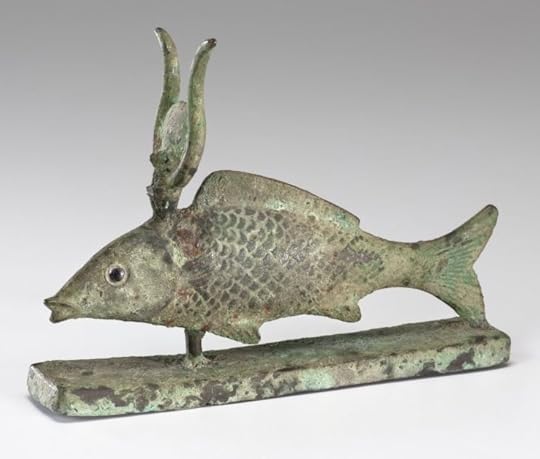 The oxyrhynchus fish with solar disk and horns crown
The oxyrhynchus fish with solar disk and horns crownWhen it comes to Isis’ story, we have a bit of a fish problem. The oxyrhynchus fish, a Nile freshwater fish and a species of elephantfish, is usually identified as the fish that ate Osiris’ phallus after it got tossed in the Nile after His dismemberment. (Though sometimes, the Nile carp or the lepidotes fish is named as the culprit.) Due to this loss, Isis had to fashion a new phallus for Osiris’ mummification and resurrection. He had to be whole.
It may have been this myth that led to Egyptian priests not being allowed to eat fish during their service, a taboo recorded by the Greek historian Herodotus. Plutarch, in his rendition of the Isis-Osiris tale, calls the fishes who ate the phallus of Osiris “impious” and says they were cursed ever after, and that Egyptians wouldn’t eat fish because of it. (Which, of course, we know is not true; they ate plenty of fish.) What’s more, the oxyrhynchus fish wasn’t cursed everywhere. It fact, it was sacred in the town of Oxyrhynchus. . Though Fish Deities were rare in Egypt, there were a few other fish that were considered sacred in different areas, and so were not eaten. And there may have been other occasional taboos on eating certain fish at certain times.
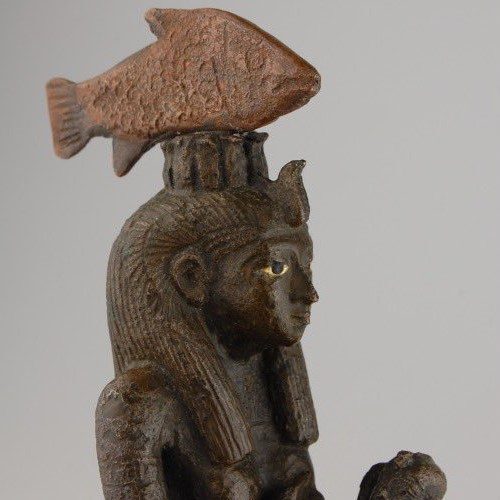 Hatmehyt
HatmehytIn addition to having this particular complication with the phallus-eating fish, our Goddess Isis has another interesting connection with the fishes.
From the New Kingdom on, Isis was assimilated with a Fish Goddess named Hatmehyt, meaning “Foremost of the Fishes.”(Or perhaps we should say that the Fish Goddess was assimilated with Her.) Hatmehyt was the chief Goddess of the delta city of Djedet (Mendes to the Greeks) where the Ram God Banebdjedet was Her consort. Banebdjedet means “Ram Lord of Djedet” or “Ba of the Lord of Djedet.” Banebdjedet came to be associated with Osiris. In the Book of the Heavenly Cow (the one that has the story of Sakhmet’s near destruction of humankind), it says specifically that the Ram of Mendes is the Ba (soul or manifestation) of Osiris.
If Banebdjedet is associated with Osiris, then Hatmehyt must be associated with Isis. Although we find a few traces of Her much earlier, Hatmehyt was most prominent during the New Kingdom and the later periods. It was because of Her growing prominence that we begin to see Her connected to more dominant Deities like Isis. Hatmehyt is usually shown as a woman with a fish emblem on Her head. Sometimes, She is fully a fish. Her fish-form is commonly identified as the schilbe, which is a kind of catfish native to Egypt. But some researchers have identified Her fish as the Nile carp, the tilapia, or even the dolphin, which were known to travel up the Nile. As Foremost of the Fishes, it may be that She can change Her fish-form at will.
 A talapia
A talapia
 Hatmehyt
HatmehytEdward Butler of Henadology notes that “mehyt,” meaning “fish” can also mean “drowned,” which is how Osiris is killed in some texts. On a Ptolemaic stele from the city of Djedet/Mendes, we find the king and queen making offering to the Deities of Djedet. Banebdjedet, in full ram-form, is there. Next to Him is a ram-headed God identified as “Ba, life of, Ba life of Wsir (?).” The question mark is a scholarly note because the name is too damaged to fully read. However, the reconstruction of the name as Usir/Osiris is based on the very clear identification of the Goddess Who stands behind Him.
She is Iset Weret Hatmehyt or “Isis the Great-Hatmehyt.” So, here is our syncretic Goddess Iset-Hatmehyt. She is Isis, Foremost of the Fishes. From an inscription on the Temple of Denderah, we learn that Hatmehyt is She Who “searches [for the members of] Her brother upon the flow.”
 A Turkana, Kenyan woman carrying a fish on her head and looking similar to some depictions of Hatmehyt
A Turkana, Kenyan woman carrying a fish on her head and looking similar to some depictions of HatmehytPerhaps as a Fish Goddess, She is particularly adept at finding His body parts in the waters or “upon the flow.” In fact, Denderah records a handful of such references to Hatmehyt searching for Osiris’ members, protecting Him in His sarcophagus, and even being His sister—just like Isis. What’s more, the son of Hatmehyt and Banebdjedet is Horus the Child. Each mythological strand weaves the connection between the two Goddesses closer.
While I never really thought about Isis as a Fish Goddess, I do recall a shapeshifting exercise with Nephthys wherein I am a fish. So perhaps, I have some meditation to do with Iset-Hatmehyt. I’m thinking there may be some wet and watery connections between the Fish Goddess and the lost-in-the-waters phallus of Osiris. The Egyptians, surrounded by desert, always thought of the waters as kinda sexy. Heqet, the fertile Frog Goddess, was no doubt rather moist and slippery, just like our perhaps-equally-moist-and-slippery Fish Goddess, Iset-Hatmehyt.
April 21, 2024
Isis of Pompeii
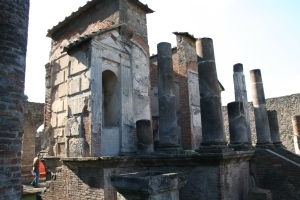 The main shrine of the Temple of Isis
The main shrine of the Temple of IsisAs you might guess, I’m always on the lookout for articles about Isis. Recently, I came across a Master’s thesis that—while it didn’t tell me much new—did remind me of the charming Isis temple in Pompeii, which is the only Italian Isis temple left standing today. I had a chance to visit it, lo those many years ago now. So I thought I’d tell you a bit about Her temple there.
One thing we know about Pompeii is that, in a city of about 20,000, about 10% of the population considered themselves Isiacs. So about 2,000 Isiacs were in Pompeii at the time it was buried in volcanic ash. Assuming you didn’t have to get them all in the sanctuary at one time (the temple grounds are not huge), that would have worked pretty well. Out of a group of about 2,000 Pagans, how many of them would actually show up for the rituals at any given time? About as many as would fit in that modest temple…a hundred, maybe 200 at most.
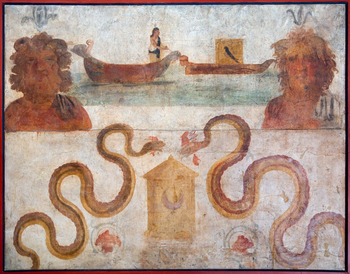 Temple fresco with Isis and Serapis, and Isis in Her boat
Temple fresco with Isis and Serapis, and Isis in Her boatBut being buried in volcanic ash wasn’t the first blow suffered by that lovely temple. Pompeii had ALSO had a recent earthquake, in 62 CE, with the Vesuvial eruption following in 79 CE. The earthquake had rattled down a lot of Pompeiian structures. In fact, one of the reasons that the Isis Temple was so well preserved (it is considered the most well preserved building in Pompeii) was that it had been rebuilt following the earthquake…and not all the other public buildings had.
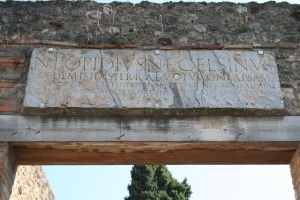 Numerius’ dedication of the temple in the name of his son
Numerius’ dedication of the temple in the name of his sonA wealthy Pompeiian, Numerius Popidius Ampliatus, had had the temple rebuilt in the name of his six-year-old son, Numerius Popidius Celsinus, so that Numerius Junior would have a free ride to the Senate. (Politics never change.) But what’s of interest to us is not the political machinations of Dad Numerius, but the fact that rebuilding the Isis temple would have conferred that much status. Clearly, Isis was popular; connections with Her and the support of Her religion were politically expedient.
 One of the amazing frescoes unearthed at the temple
One of the amazing frescoes unearthed at the templeThe temple was located behind the city’s main theatre building, which emphasizes the close relationship between Isis and the God of the Theatre, Dionysos or Bacchus. Dionysos was identified with Osiris; and so, He was a natural partner for Isis. In fact, a sacred image of Dionysos, along with His requisite panther, was located in a special niche on the backside of the main Isis shrine.
On either side of the Dionysos image was a pair of large, stuccoed ears. The existence of these ears shows a direct connection between the Italian temple and Egyptian tradition. Egyptian temples often had God-sized ears carved on the back of the temple, just behind the innermost shrine. The common folk, who could not enter the holy of holies, could—by virtue of these Divine ears—speak directly to the Goddess or God of the temple. A hole drilled through the back of the temple, and a priest or priestess on the other side, served to transmit the concerns of the suppliant to the Deity. No doubt the same thing was intended in Pompeii.
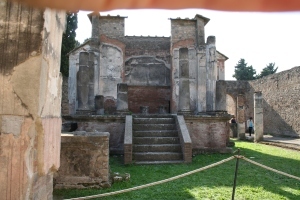
This next photo is the main shrine, the naos and pronaos, of the Isis temple. The sacred images of Isis and Osiris would have stood here.
There was a mosaic floor in this area, which has now been lost. Lost where? I don’t know. Perhaps stolen from the site. On either side of the main entrance (the central opening you see here), were two niches, perhaps intended for images of Anubis and Harpocrates, to Whom two altars within the sanctuary were dedicated.
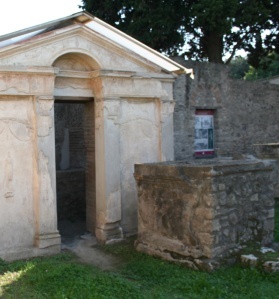 The small building where the sacred water for the Isis rites was kept
The small building where the sacred water for the Isis rites was keptThe low structure on the left is the main altar; the remains of a sacrificial fire and burnt offerings were found there.
Just to the left of the main altar is a small building where they kept the sacred water for purification. Likely, this would have been Nile water. Roman satirists mocked female Isis devotees for making pilgrimage to Egypt to bring back the sacred waters of the Nile. (We cannot be sure whether the satirists were more interested in mocking Isiacs or women by such statements, but either way, nice, huh?) The sacred water was kept in an underground chamber.
You can see a little way into the building, which is about the size of one of those pre-fab garden sheds. The main altar is on the right, in front of the building.
The thing we can’t really imagine from any of these pictures is how the living temple would have looked. Paintings covered most all the walls; colorful mosaics decorated both walls and floors; shaven-headed priests and veiled priestesses moved to and fro in service to the Goddess.
 This one isn’t from Pompeii, but from Herculaneum; you can see that they were indeed trying to keep the “Egyptian” in temples of Egyptian Deities
This one isn’t from Pompeii, but from Herculaneum; you can see that they were indeed trying to keep the “Egyptian” in temples of Egyptian DeitiesBehind the main shrine, there was a large-ish room in which, I subsequently learned, the initiates of Isis met. I didn’t take a picture of it because the site really didn’t look like anything much. But that was because they took all the good stuff to the museum. The walls had been covered with images evocative of Egypt. Near the entrance, archeologists found a beautiful marble head of Isis. The body of the image was of wood and was dressed in garments of real fabric and would have been cared for on a daily basis by the temple personnel.
This is not that image. But it IS one of the statues rescued from the temple. I didn’t get to see it in person because the Naples Museum had that wing of the museum closed the day we were there. Dang. From what I’m reading, it looks like they may have made a replica and put it in place in the sanctuary. I hope so. Let me know if you’ve seen it.
At any rate, this is one of my favorite non-Egyptian Isis images, and I leave you with Her graceful Self:
 One of the images of Isis in the Naples Museum
One of the images of Isis in the Naples Museum
April 14, 2024
A Day of Rest
I’m recovering today from a bit of surgery, so I will leave you with this photo of some Isis statuettes we were privileged to see at the Egyptian Museum in Cairo. Isis, Isis everywhere!

April 7, 2024
She Will Hear You

So many folks I know are going through something right now. I’m not talking about The State of the World. (That’s a whole other difficult story.) I’m talking about personal things that loom large in our own lives. Health. Family. Huge decisions. Scary changes.
Maybe it’s just spring?
Because as beautiful and as welcome as each spring is, there’s also something unsettling about it. Everything is roaring to get going. But we’re not quite there yet. And we can’t quite move yet. Do you feel it, too? I know I do.
So you may be wondering, “Where is Isis in all this?”

She is here.
As She has always been.
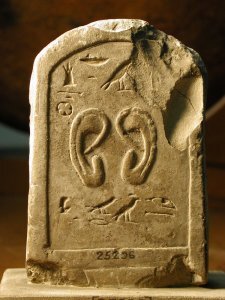 An Egyptian votive stela asking for the Deity to hear.
An Egyptian votive stela asking for the Deity to hear.And She is listening.
Isis is one of the Deities particularly known to hear our human cries, to hear our prayers. She is called the One Who Listens. In ancient texts and on temple walls, Isis is She Who Hears Petitions; Who Hears the Petitions of Millions. She is particularly known to come at the invocation of Her devotees: Isis is She Who Comes to the Calling; people Call to Her in Every Place. A graffito from Thebes says, “O you of all lands, call to Isis, the Great Goddess, She listens at every moment!”
Why then does She not snap Her magical fingers and make it all go away? Because that’s not how it works. Whatever we are going through, these are our problems to solve. And we will solve them—with a little help from our friends.
Isis reminds us that we are each a feather in Her Wings, the blood in Her veins, an extension of the magic in Her heart and in Her hands.
This is a time not to neglect our connection with Her. Meditate, make offerings, chant. She invites us to let our souls fly to Her and be enfolded in Her Wings. “Bring your heart to Me,” She says. “Speak pain. Speak truth.” She will take us as we are right now.
For She listens. And She hears.



